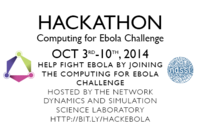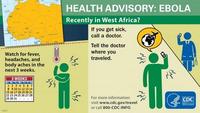-
CDC chief: U.S. “rethinking” Ebola strategy after Dallas nurse’s infection
U.S. federal health officials have urged hospitals to “think Ebola” as officials in Texas are anxiously trying to identify all staff involved in the care of America’s patient zero following the news that a nurse — Nina Pham, 26 — who was involved in his care is the first person to contract the disease in the United States. “We have to rethink the way we address Ebola infection and control because even a single infection is unacceptable,” Tom Frieden, director of the CDC, said on Monday. CDC officials are now watching the Dallas hospital personnel as they put on and take off their protective garb, retraining the staff and evaluating the type of protective equipment being used. The CDC officials were considering using cleaning products that kill the virus to spray down workers who come out of the isolation unit where the nurse is being treated. CDC will update its infection control guidance document, mostly likely next week. The agency’s guidance is just that – a guidance – since the agency does not have the authority to compel hospitals to follow its recommended procedures.
-
-
Ebola vaccine trials begin in Mali
The Center for Vaccine Development (CVD) at the University of Maryland School of Medicine (UM SOM), in conjunction with the Center for Vaccine Development of Mali (CVD-Mali) and the Ministry of Health of Mali, have begun a clinical trial in health care workers (and other front-line workers) to evaluate a promising experimental Ebola vaccine. The trial began on Wednesday, 8 October, with the vaccination of the first subject, followed by two additional participants on 9 October — all three being Malian health care workers. In the coming weeks, thirty-seven more health care workers will receive the vaccine.
-
-
The mathematics of the Ebola epidemic
The Ebola epidemic in West Africa appears to be spiraling out of control. Local and global health authorities want to know how the epidemic will develop and, above all, how to prevent it from spreading further. Certain parameters help them to determine this, such as the reproductive number, which is the average number of infections caused by a single infected individual. Researchers, using the data available – for example, gene sequence of the virus in various patient samples — have calculated that in the current outbreak, the viral reproductive number is 2.18: Every infected individual on average causes 2.18 additional infections.
-
-
Pentagon’s medical countermeasures helpful in fighting Ebola outbreak
The U.S. Defense Department is better prepared to help with the West Africa Ebola outbreak because it has accelerated aspects of its medical countermeasures program established to protect troops from biological warfare agents, Andrew C. Weber, assistant secretary of defense for Nuclear, Chemical and Biological Defense Programs said the other day. “Ebola has always been on the threat list of agents that we’re concerned about,” Weber said, adding that DoD and the Department of Health and Human Services have been the only investors in medical countermeasures for such historically rare contagions as Ebola virus disease. Among the products whose development or availability the department has accelerated in response to the outbreak in West Africa is a vaccine against the Zaire strain of Ebola that is causing the epidemic.
-
-
U.S. to commit 4,000 soldiers, $750 million in the next six months to fight Ebola in Africa

The Pentagon’s effort to help eradicate Ebola in West Africa will require roughly 4,000 American soldiers, cost $750 million for the next six months, and may last longer than a year.American troops will help build seven testing labs and seventeen treatment facilities by mid-November, but troops will be on the ground in Liberia for at least a year.A majority of U.S. soldiers will not come in direct contact with Ebola patients, but a few dozen troops trained to operate in nuclear, biological, and chemical environments will be assigned to testing labs.
-
-
Texas officials question state preparedness for an outbreak
Following the death of Texas Ebola patient Thomas Duncan, many leaders in Texas are considering whether the state is prepared to handle a more wide scale public health emergency. The problem, analysts say, is that many local health departments in the state are run autonomously, and have split funding between local, state, and federal sources. As a result, they are not often all held to the same standard, and these disparities could be what would ultimately lead to disjointedness and failure to respond properly to an outbreak.
-
-
The U.S. is not at risk of an Ebola epidemic: Experts
The United States is highly unlikely to suffer an Ebola outbreak, according to the Centers for Disease Control and Prevention(CDC). Although U.S. hospitals have not had to deal with Ebola in the past, Western health institutions have studiedthe disease since it was first discovered in 1976 in Zaire, now the Democratic Republic of the Congo, positioning the CDC better to inform the public about Ebola, its symptoms, and how it spreads.
-
-
Computing for Ebola Challenge

Researchers at the Network Dynamics and Simulation Science Laboratory (NDSSL) have been using a combination of modeling techniques to predict the spread of the Ebola outbreak. As part of those efforts, the team created an adaptable set of global synthetic populations, allowing for rapid response as the situation continues to unfold. The synthetic populations and other informatics resources are now openly available to aid other researchers and citizen scientists. The NDSSL is hosting a Computing for Ebola Challenge from 3 October to 10 October 2014. The goal of the hackathon is to develop an application to combat the Ebola epidemic. All are welcome to join.
-
-
Candidates of both parties use Ebola crisis to attack opponents
Democratic and Republican campaign officials are uncertain about the political ramifications of Ebola’s arrival in the United States, but some congressional candidates have already used the topic to connect with voters. A poll by the National Republican Senatorial Committee(NRSC), the campaign group for Senate Republicans, found that 60 percent of voters believe Ebola should be treated as a major crisis by the White House if a single case of Ebola is found in the United States. Even congressional Democrats who have been supportive of Obama’s position toward the Ebola crises have used the Ebola epidemic against opponents.
-
-
CDC urges hospitals to follow Ebola-related protocols

The CDC had called for medical facilities to be on high-alert for Ebola-like symptoms, but these plans are only as effective as the practices of each hospital, and the recent Dallas case was marked by a mix-up at Texas Health Presbyterian Hospital. “We’re reiterating the message for every health worker in this country — think about travel history. If someone’s been in West Africa within twenty-one days and they’ve got a fever, immediately isolate them and get them tested for Ebola,” CDC director Thomas Frieden said.
-
-
Securiport’s advanced biometric immigration control systems help in fight against Ebola
Securiport says it is supporting the fight against the Ebola virus in West Africa by providing advanced biometric screening technologies and comprehensive contact tracing data analytics to help governments and health organizations monitor and control the spread of the virus. The company’s immigration control systems are now in place across a total of seven West African nations, including Sierra Leone, Senegal, and Ivory Coast.
-
-
Mopping up toxic fire-fighting chemicals

Australian scientists have come up with the solution to a world-wide pollution problem — how to mop up the toxic residues left after the use of special foams to fight fires. The technology uses a modified clay to soak up potential cancer-causing substances in the foam used by fire fighters, defense facilities, and airports worldwide to suppress fires.
-
-
Dallas Ebola patient was sent home as a result of a flaw in software used by many hospitals

Before Thomas Eric Duncan was placed in isolation for Ebola at Dallas’ Texas Health Presbyterian Hospitalon 28 September, he sought care for fever and abdominal pain three days earlier, but was sent home. During his initial visit to the hospital, Duncan told a nurse that he had recently traveled to West Africa — a sign that should have led hospital staff to test Duncan for Ebola. Instead, Duncan’s travel record was not shared with doctors who examined him later that day. This was the result of a flaw in the way the physician and nursing portions of our electronic health records (EHR).EHR software, used by many hospitals, contains separate workflows for doctors and nurses.
-
-
Sandia researchers find clues to superbug evolution
Imagine going to the hospital with one disease and coming home with something much worse, or not coming home at all. With the emergence and spread of antibiotic-resistance pathogens, healthcare-associated infections have become a serious threat. On any given day about one in twenty-five hospital patients has at least one such infection and as many as one in nine die as a result, according to the Centers for Disease Control and Prevention (CDC). A team of Sandia National Laboratories microbiologists for the first time recently sequenced the entire genome of a Klebsiella pneumoniae strain, encoding New Delhi Metallo-beta-lactamase (NDM-1). Klebsiella pneumoniae is not typically a ferocious pathogen, but now armed with resistance to virtually all antibiotics in current clinical use.
-
-
FDA, industry face pressures to ensure safety of food ingredients
Confusion over a 1997 Food and Drug Administration (FDA) rule that eases the way for food manufacturers to use ingredients “generally regarded as safe,” or GRAS, has inspired a new initiative by food makers. Food safety advocates say the current GRAS process allows substances into the food supply that might pose a health risk, while industry defends its record.
-
More headlines
The long view
We Ran the C.D.C.: Kennedy Is Endangering Every American’s Health
Nine former leaders of the Centers for Disease Control and Prevention (CDC), who served as directors or acting directors under Republican and Democratic administrations, serving under presidents from Jimmy Carter to Donald Trrump, argue that HHS Secretary Roert F. Kennedy Jr. poses a clear and present danger to the health of Americans. He has placed anti-vaxxers and conspiracy theorists at top HHS positions, and he appears to be guided by a hostility to science and a belief in bizarre, unscientific approaches to public health.
